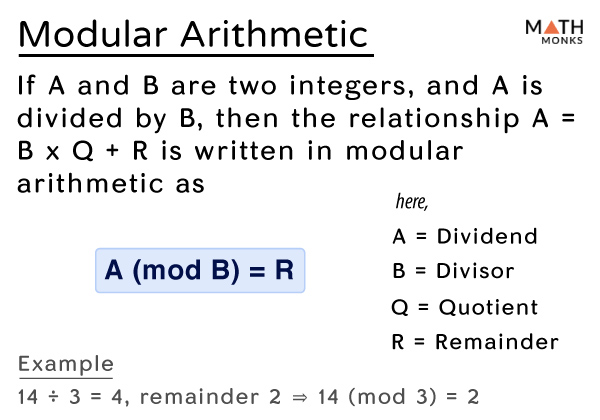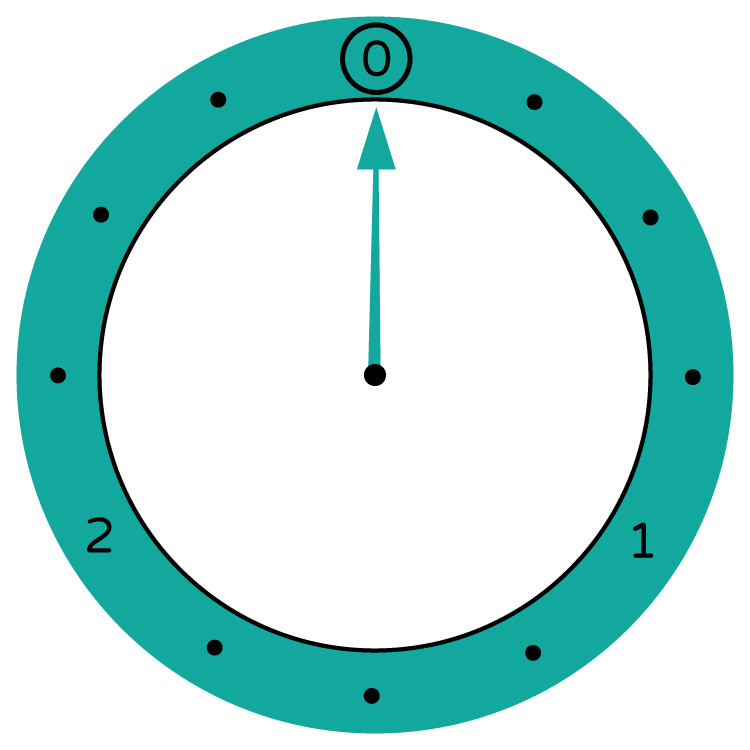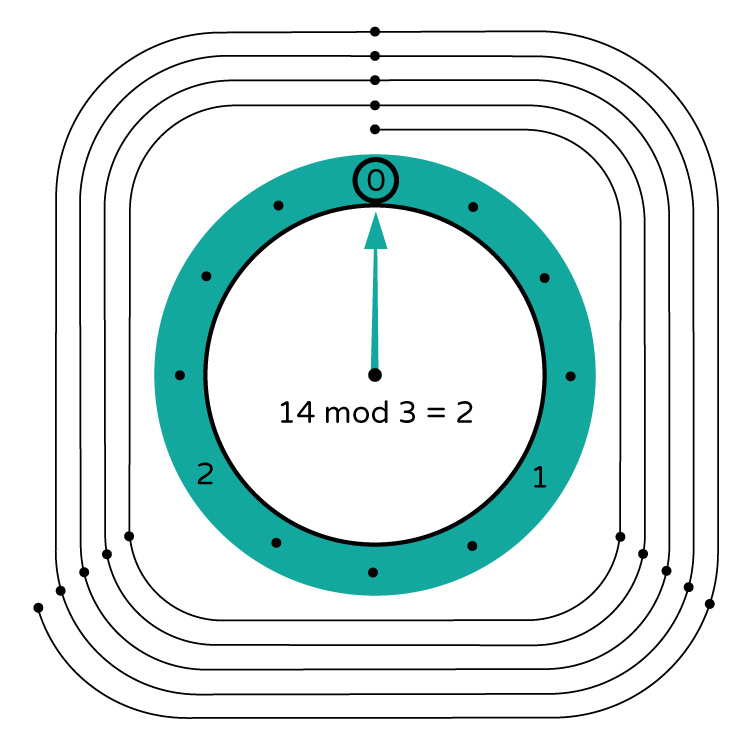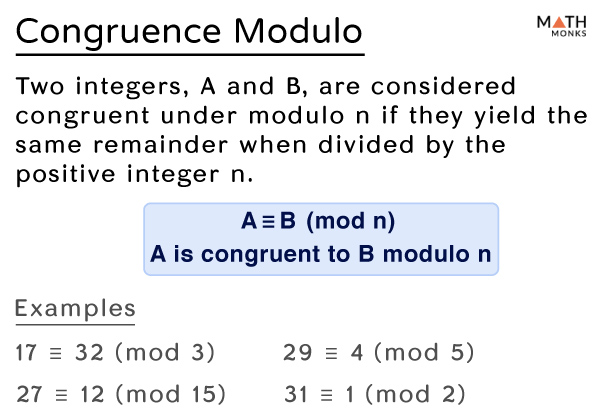Modular arithmetic, also known as clock arithmetic, deals with finding the remainder when one number is divided by another number. It involves taking the modulus (in short, ‘mod’) of the number used for division.
If ‘A’ and ‘B’ are two integers such that ‘A’ is divided by ‘B,’ then:
${\dfrac{A}{B}=Q,remainderR}$
Here,
- Dividend = A
- Divisor = B
- Quotient = Q, and
- Remainder = R
In modular arithmetic, it is written as A mod B = R, read as ‘A modulo B equals R’ where ‘B’ is referred to as modulus. This means if we divide ‘A’ by ‘B’ the remainder is ‘R.’
For example, ${\dfrac{14}{3}=4,remainder2}$ ⇒ 14 mod 3 = 2, which means if 14 is divided by 3, the remainder is 2.
The concept of modular arithmetic can be best explained using the face of a clock. It has many applications in fields like cryptography, computer science, and number theory, and it is often used to detect errors in identification numbers.
Visualizing Modulus with a Clock
Now, let us visualize the modulo operator with a clock. To find the result of 14 mod 3 (A mod B), we will follow the following steps:
Step 1: Constructing the clock for size ‘B’
First, we write 0 at the top of the clock and continue clockwise by writing 1, 2, … up to one less than the modulus. Here, 14 mod 3, the modulus is 3. Thus, 12 is replaced by a 0, then continuing 1 and 2 (= 3 – 1) in the clockwise direction of the circle, which is for the modulus of 3.
Step 2: Starting at 0 and moving around the clock for ‘A’ steps
Here, we start from 0, increase the number by 1 in each step, and divide them by 3. This continues until the number reaches one less than the number we are dividing by. After that, the sequence repeats.
On dividing by 3, we get
- ${\dfrac{0}{3}=0,remainder0}$
- ${\dfrac{1}{3}=0,remainder1}$
- ${\dfrac{2}{3}=0,remainder2}$
- ${\dfrac{3}{3}=1,remainder0}$
- ${\dfrac{4}{3}=1,remainder1}$
- ${\dfrac{5}{3}=1,remainder2}$
- ${\dfrac{6}{3}=2,remainder0}$
- ${\dfrac{7}{3}=2,remainder1}$
- ${\dfrac{8}{3}=2,remainder2}$
- ${\dfrac{9}{3}=3,remainder0}$
- ${\dfrac{10}{3}=3,remainder1}$
- ${\dfrac{11}{3}=3,remainder2}$
- ${\dfrac{12}{3}=4,remainder0}$
- ${\dfrac{13}{3}=4,remainder1}$
- ${\dfrac{14}{3}=4,remainder2}$
Step 3: Finding the Solution
Thus, we get the solution 2.
Congruence Modulo
Two integers, ‘A’ and ‘B,’ are considered congruent under modulo ‘n’ if they yield the same remainder when divided by the positive integer ‘n.’
For example,
17 and 32 are congruent to modulo 3, which implies 17 ≡ 32 (mod 3). This means the remainder of dividing ‘17 by 3’ and ‘32 by 3’ are 2.
In general, two integers, ‘A’ and ‘B,’ are congruent to modulo ‘n’ when (A – B) is a multiple of ‘n,’ which means A ≡ B when ${\dfrac{A-B}{n}}$ is an integer. However, A ≢ B (mod n) means that ‘A’ and ‘B’ are not congruent to modulo ‘n.’
![]() Find the value of 516 in modulo 7
Find the value of 516 in modulo 7
Solution:
![]()
As we know, 516 ÷ 7 = 73, remainder 5
Thus, 516 ≡ 5 (mod 7), which means 5 is the value of 516 in modulo 7
Rules
While solving modular arithmetic problems, we directly operate on the remainder without tedious computations, following the given rules or properties.
Addition
- If A + B = C, then A (mod n) + B (mod n) ≡ C (mod n)
- If A ≡ B (mod n), then A + k ≡ B + k (mod n) for any integer ‘k’
- If A ≡ B (mod n) and C ≡ D (mod n), then A + C ≡ B + D (mod n)
- If A ≡ B (mod n), then -A ≡ -B (mod n)
![]() Find the value of (32 + 47) in modulo 6
Find the value of (32 + 47) in modulo 6
Solution:
![]()
As we know, if A + B = C, then A (mod n) + B (mod n) ≡ C (mod n)
Here, (32 + 47) = 79
Now, using the properties of addition, we get
32 (mod 6) + 47 (mod 6) ≡ 79 (mod 6) ≡ 1 (mod 6)
Thus, the value of (32 + 47) in modulo 6 is 1
Subtraction
The same rules for modular addition can also be applied to modular subtraction.
![]() Find the remainder when the difference between 458 and 192 is divided by 5.
Find the remainder when the difference between 458 and 192 is divided by 5.
Solution:
![]()
Here,
458 = 5(91) + 3, the remainder is 3 when 456 is divided by 5
192 = 5(38) + 2, the remainder is 2 when 192 is divided by 5
Now, 458 ≡ 3 (mod 5) and 192 ≡ 2 (mod 5), which implies 458 – 192 ≡ 3 – 2 ≡ 1 (mod 5).
Thus, the remainder is 1 when the difference of 458 and 192 is divided by 5
Multiplication
- If A ⋅ B = C, then A (mod n) ⋅ B (mod n) ≡ C (mod n)
- If A ≡ B (mod n), then kA ≡ kB (mod n) for any integer ‘k’
- If A ≡ B (mod n) and C ≡ D (mod n), then AC ≡ BD (mod n)
![]() Solve: (15 × 81) (mod 12)
Solve: (15 × 81) (mod 12)
Solution:
![]()
Here, the value of (15 × 81) (mod 12) is expressed as 15 (mod 12) × 81 (mod 12)
Since 15 ≡ 3 (mod 12) and 81 ≡ 9 (mod 12) ⇒ (15 × 81) ≡ (3 × 9) ≡ 27 ≡ 3 (mod 12)
Division
We note that modular division is different from addition, subtraction, and multiplication. This means
${\dfrac{A}{B}\left( mod \ n\right)}$ does not equal to ${\left( \dfrac{A\left( mod \ n\right) }{B\left( mod \ n\right) }\right) \left( mod \ n\right)}$
Here, we calculate ${\dfrac{A}{B}\left( mod \ n\right)}$ using the following formula:
${\dfrac{A}{B}\left( mod \ n\right)}$ = (A × (inverse of B, if it exists)) (mod n)
However, if we add the condition that k and n are coprime to each other, then the division becomes well-defined.
Mathematically, if gcd(k, n) = 1 and kA ≡ kB (mod n), then A ≡ B (mod n), which means if k(A – B) is a multiple of ‘n’ and gcd(k, n) = 1, then ‘n’ divides (A – B) or A ≡ B (mod n)
Multiplicative Inverse
The modular inverse of ‘A’ in modulo ‘n’ exists if only if ‘A’ and ‘n’ are relatively prime.
Thus, if gcd(A, n) = 1 and (A ⋅ B) (mod n) = 1 ⇒ (A ⋅ B) ≡ 1 (mod n), then ‘B’ is the modular inverse of ‘A.’
For example,
A = 7, n = 9, and (7 × 4) ≡ 1 (mod 9), thus, 4 is the modular inverse of 7.
Exponentiation
If A ≡ B (mod n), then Ak ≡ Bk (mod n) for any positive integer ‘k’
Let us find the value of 221 (mod 5)
Since 20 ≡ 1 (mod 5)
21 ≡ 2 (mod 5)
22 ≡ 4 (mod 5)
23 ≡ 3 (mod 5)
24 ≡ 1 (mod 5)
We observe that the result repeats after every multiple of 4. Thus, 221 ≡ (24)5 × 21 ≡ 1 × 2 ≡ 2 (mod 5), means 221 in modulo 5 is 2.
In the above example, we do not need to find the exact value of 221, which is very large. In such cases, we can find the last digit of any number raised to a big exponent.
![]() Determine the last digit of the remainder when 1339 is divided by 4.
Determine the last digit of the remainder when 1339 is divided by 4.
Solution:
![]()
Since the last digit of 130 = 1,
the last digit of 131 = 3,
the last digit of 132 = 9,
the last digit of 133 = 7,
and the last digit of 134 = 1. The cycle repeats as 1, 3, 9, 7, and again it is 1
Here, the last digit of 1339 = (134)9 ⋅ 133 = (1)9 ⋅ 7 = 7
Thus, the last digit of 1339 is 7 ⇒ 1339 ≡ 3 (mod 4)
Using a Calculator
For calculating 1258 in modulo 4 (as ‘A’ in modulo ‘n’) using a standard calculator, we follow the following steps:
Step 1: Dividing ‘A’ by ‘n’
1258 ÷ 4 = 314.5
Step 2: Subtracting the whole Part of the Resulting Quantity
314.5 – 314 = 0.5
Step 3: Multiplying the Difference by ‘n’ to Obtain the Modulus
0.5 × 4 = 2Thus, we get 1258 ≡ 2 (mod 4)




